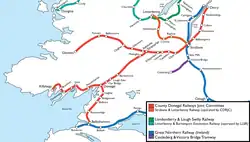The County Donegal Railways Joint Committee operated an extensive 3 ft (914 mm) narrow gauge railway system serving County Donegal, Ireland, from 1906 until 1960. The committee was incorporated by an Act of Parliament in 1906, which authorised the joint purchase of the then Donegal Railway Company by the Great Northern Railway of Ireland and the Midland Railway Northern Counties Committee.
History of the County Donegal Railways Joint Committee
On 1 May 1906, the Joint Committee was set up. The lines inherited by the Joint Committee totalled 106 miles (171 km) and were:
- Finn Valley Railway (FVR) from Strabane to Stranorlar
- West Donegal Railway line from Stranorlar to Donegal
- The Donegal Railway Company lines between Stranorlar and Glenties, Donegal Town to Killybegs, Strabane to Derry, and Donegal Town to Ballyshannon
By 1912 the company owned the following assets:[1]
- Locomotives and rolling stock: 21 locomotives; 56 passenger vehicles; 304 goods vehicles
- Head offices and locomotive works at Stranorlar
The Strabane to Derry line was completely owned by the Midland Railway Northern Counties Committee, although it was operated by the CDRJC.[2]
At its greatest extent, the County Donegal Railways Committee operated the largest narrow gauge railway system in the British Isles. The railway was affectionately known as the "Wee Donegal".[3]
The Joint Committee opened the Strabane and Letterkenny Railway on 1 January 1909, bringing the total mileage operated by the company to 124.5 miles (200.4 km). Only 91 miles (146 km) were directly owned by the Joint Committee, as the Strabane and Letterkenny Railway accounted for 19.25 miles (30.98 km), and 14.5 miles (23.3 km) were property of the Northern Counties Committee.[4]
Dieselisation
Under the management of Henry Forbes, traffic superintendent from 1910 to 1943, the County Donegal Railways became pioneers in the use of diesel traction.[5] The first diesel railcar was built in 1930 (the first diesel railcar anywhere in the British Isles), although a petrol-engined railcar had been built in 1926 before standardisation on diesel traction in 1934. Eight articulated diesel railcars were constructed by Walker Brothers of Wigan between 1934 and 1951, by which time virtually all passenger services were operated by diesel railcar, being much cheaper to operate than conventional steam trains.
The railcars could only be driven from one end and had to be turned on a turntable to make a return journey. As well, they could not be worked in multiple, so if two railcars were working back to back, both required a driver. The railcars were incapable of hauling most freight wagons, so steam traction continued to be used on freight and excursion trains. The railcars could haul specially constructed trailers, and some lightweight freight wagons, which were painted red to distinguish them from the heavier wagons, which were grey. A diesel locomotive named Phoenix (converted from a steam locomotive) was also used, but due to its noisy operation and slow speed (top speed of 27 mph or 43 km/h), it spent most of its career shunting, travelling 204,577 miles (329,235 km) during its working life.[6]
Closure
The Glenties branch closed in 1947, the Strabane-Derry line closed in 1954, and the remaining passenger services ended on 31 December 1959. Much of the railway was closed on that date. Goods trains ran between Strabane and Stranorlar until 6 February 1960.
During the 1930s the Joint Committee began operating a fleet of buses. After the closure of the railway, it continued to operate as a road freight and bus company until 10 July 1971 when it was taken over by CIÉ.[7]
In 1961, the two most modern diesel railcars were sold to the Isle of Man Railway.
Tourist attraction

Part of the line, which runs alongside Lough Finn near Fintown, has been re-laid as a tourist railway.[8]
The Donegal Railway Heritage Centre has been established and contains historic details and artefacts of the CDRJC.[9]
St. Connell's Museum, in Glenties has an extensive display of items from the railway.[10]
The Foyle Valley Railway in Derry houses numerous CDRJC artefacts. It used to operate a small heritage railway along the Foyle on the original route of the Derry-Portadown railway line, which has since fallen into disrepair during the museum's period of closure.
In preservation
- Carriages: 1 (UFTM), 3 (UFTM), 5 (DRC) 14 (FVR), 28 (DRC), 30 (FVR)
- Goods wagons: 12 (DRC), 19 (FVR), 136 (UFTM), Unidentified horsebox (BHR), Unidentified Van (DRC)
UFTM = Ulster Folk & Transport Museum; FVR = Foyle Valley Railway; BHR = Belturbet Heritage Railway; FTR = Fintown Railway; DRC = Donegal Railway Centre; IOMR = Isle of Man Railway; C&L = Cavan and Leitrim Railway
Rolling stock
| Number | Name | Built | Manufacturer | Configuration | Notes | Image |
|---|---|---|---|---|---|---|
| Class 1 | ||||||
| No. 1 | Alice | 1881 | Sharp, Stewart and Company | 2-4-0 | Loaned to Cork, Blackrock and Passage Railway from 1918-1921. Scrapped 1926. | |
| No. 2 | Blanche | 1881 | Sharp, Stewart and Company | 2-4-0 | Withdrawn in 1905.
Scrapped in 1909. |
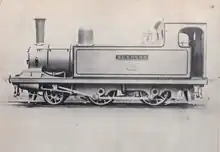 Builder's photo of No. 2 Blanche. |
| No. 3 | Lydia | 1881 | Sharp, Stewart and Company | 2-4-0 | Withdrawn in 1905.
Scrapped in 1910. |
|
| Class 2 | ||||||
| No. 4 | Meenglas | 1893 | Neilson and Company | 4-6-0 | Scrapped in 1935. | 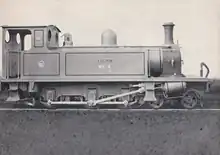 Builder's photo of No. 4 Meenglas. |
| No. 5 | Drumboe | 1893 | Neilson and Company | 4-6-0 | Withdrawn in 1927.
Scrapped in 1931. |
|
| No. 6 | Inver | 1893 | Neilson and Company | 4-6-0 | Withdrawn in 1927.
Scrapped in 1931. |
|
| No. 7 | Finn | 1893 | Neilson and Company | 4-6-0 | Withdrawn in 1927.
Scrapped in 1931. |
|
| No. 8 | Foyle | 1893 | Neilson and Company | 4-6-0 | Scrapped in 1937. |  No. 8 Foyle between Fintown and Glenties in July 1924. |
| No. 9 | Columbkille | 1893 | Neilson and Company | 4-6-0 | Scrapped in 1937. | |
| Class 3 | ||||||
| No. 10 | Sir James | 1902 | Neilson and Company | 4-4-4 | Scrapped in 1935. |  Builder's photo of No. 10 Sir James. |
| No. 11 | Hercules | 1902 | Neilson and Company | 4-4-4 | Scrapped in 1935. | |
| Class 4 | ||||||
| No. 12
No. 9 |
Eske | 1904 | Nasmyth, Wilson and Company | 4-6-4 | Renumbered No. 9 in 1937.
Scrapped in 1954. |
|
| No. 13
No. 10 |
Owenea | 1904 | Nasmyth, Wilson and Company | 4-6-4 | Renumbered No. 10 in 1937.
Scrapped in 1952 after a collision with railcar No. 17 in 1949. |
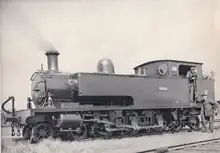 No. 10 Owenea at Strabane on 14 May 1937. |
| No. 14
No. 11 |
Erne | 1904 | Nasmyth, Wilson and Company | 4-6-4 | Renumbered No. 11 in 1937.
Scrapped in 1967. |
 No. 14 Erne. |
| No. 15
No. 12 |
Mourne | 1904 | Nasmyth, Wilson and Company | 4-6-4 | Renumbered No. 12 in 1937.
Withdrawn in 1940, dismantled for spare parts. |
|
| Class 5 | ||||||
| No. 16
No. 4 |
Donegal
Meenglas |
1907 | Nasmyth, Wilson and Company | 4-6-2 | Renumbered No. 4 and renamed Meenglas in 1937.
Preserved at the Foyle Valley Railway Museum. |
 No. 4 Meenglas in preservation. |
| No. 17
No. 5 |
Glenties
Drumboe |
1907 | Nasmyth, Wilson and Company | 4-6-2 | Renumbered No. 5 and renamed Drumboe in 1937.
Ran the last scheduled train of the CDRJC on 31 December 1959. Preserved at the Donegal Railway Heritage Centre. |
 No. 17 Glenties before renumbering and renaming at Stranorlar on 14 May 1937. |
| No. 18
No. 6 |
Killybegs
Columbkille |
1907 | Nasmyth, Wilson and Company | 4-6-2 | Renumbered No. 6 and renamed Columbkille in 1937.
Preserved at the Foyle Valley Railway Museum. |
 No. 6 Columbkille in preservation. |
| No. 19 | Letterkenny | 1908 | Nasmyth, Wilson and Company | 4-6-2 | Dismantled in 1940 for spare parts. | |
| No. 20
No. 8 |
Raphoe
Foyle |
1908 | Nasmyth, Wilson and Company | 4-6-2 | Renumbered No. 8 and renamed Foyle in 1937.
Scrapped in 1955. |
|
| Class 5A | ||||||
| No. 1 | Alice | 1912 | Nasmyth, Wilson and Company | 4-6-2 | Sold at a scrap auction in 1960. |  No. 1 Alice at Londonderry Victoria Road on 20 August 1950. |
| No. 2A
No. 2 |
Blanche | 1912 | Nasmyth, Wilson and Company | 4-6-2 | Renumbered No. 2 shortly after arrival.
Preserved in the Ulster Folk and Transport Museums in Cultra. |
 No. 2 Blanche in preservation. |
| No. 3A
No. 3 |
Lydia | 1912 | Nasmyth, Wilson and Company | 4-6-2 | Renumbered No. 3 shortly after arrival.
Sold at a scrap auction in 1960. |
 No. 3 Lydia at Stranorlar on 14 May 1937. |
| Atkinson-Walker rail tractor | ||||||
| No. 11 | Phœnix | 1928 | Atkinson-Walker | 0-4-0 | Sold by the Clogher Valley Railway to the CDRJC in December 1931.
No. 11 Phœnix was converted from steam power to diesel power and operated as a shunter. Preserved at the Ulster Folk and Transport Museums. |
 No. 11 Phœnix in preservation. |
| Number | Start of Operation | Source or Manufacturer | Power | Notes | Image |
|---|---|---|---|---|---|
| No. 1 | 1906 | Allday & Onions | Petrol | Preserved in the Ulster Folk and Transport Museums in Cultra. | .jpg.webp) Railcar No. 1 in preservation. |
| No. 2 | 1926 | ex-Derwent Valley Light Railway | Petrol | Scrapped in 1934. | 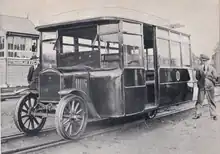 Railcar No. 2 at Stranorlar with Henry Forbes (left) and Ross Parks (right). |
| No. 2 | 1934 | ex-Castlederg and Victoria Bridge Tramway | Petrol | Rebuilt as a trailer in 1944.
Sold in 1961 and removed to Mountcharles. |
|
| No. 3 | 1926 | ex-Derwent Valley Light Railway | Petrol | Scrapped in 1934. | |
| No. 3 | 1934 | ex-Dublin and Blessington Steam Tramway | Petrol | Rebuilt as a trailer in 1944.
Preserved at the Ulster Folk and Transport Museums in Cultra. |
 ex-D&BST railcar-turned trailer in preservation. |
| No. 4 | 1928 | O'Doherty | Petrol | Lent to the Clogher Valley Railway in 1932.
Scrapped in 1947. |
|
| No. 5 | 1929 | O'Doherty/Knutsford | Petrol | Built as a trailer. Sold in 1960. | |
| No. 6 | 1930 | Great Northern Railway (Ireland) and O'Doherty | Petrol | Rebuilt as a trailer in 1945.
Sold in 1958 and removed to Inver. |
 Railcar No. 6 and Railcar No. 7 at Ballintra. |
| No. 7 | 1930 | Great Northern Railway (Ireland) and O'Doherty | Diesel | First diesel railcar in the British Isles.
Scrapped in 1949. |
 Railcar No. 7 at Stranorlar. |
| No. 8 | 1931 | Great Northern Railway (Ireland) and O'Doherty | Diesel | Scrapped in 1949. | |
| No. 9 | 1933 | County Donegal Railways Joint Committee ex-Great Northern Railway (Ireland) bus | Petrol | Scrapped in 1949. | |
| No. 10 | 1933 | County Donegal Railways Joint Committee | Petrol | Destroyed by a fire in Ballyshannon in 1939. | |
| No. 11
Phœnix |
1933 | ex-Clogher Valley Railway and Atkinson-Walker | Diesel | Preserved. | .jpg.webp) No. 11 Phœnix in preservation. |
| No. 12 | 1934 | Great Northern Railway (Ireland) and Walker Brothers | Diesel | Preserved at the Foyle Valley Railway. | _-_geograph.org.uk_-_2337722.jpg.webp) Railcar No. 12 & No. 18 at the Shane's Castle railway in Antrim. |
| No. 13 | 1934 | ex-Dublin and Blessington Steam Tramway | Diesel | Rebuilt as a trailer in 1934.
Scrapped in 1944. |
|
| No. 14 | 1935 | Great Northern Railway (Ireland) and Walker Brothers | Diesel | Scrapped in 1961. | |
| No. 15 | 1936 | Great Northern Railway (Ireland) and Walker Brothers | Diesel | Scrapped in 1961. | |
| No. 16 | 1936 | Great Northern Railway (Ireland) and Walker Brothers | Diesel | Preserved at the Donegal Railway Heritage Centre. | |
| No. 17 | 1938 | Great Northern Railway (Ireland) and Walker Brothers | Diesel | Destroyed in collision with No. 10 Owenea in 1949. | |
| No. 18 | 1940 | Great Northern Railway (Ireland) and Walker Brothers | Diesel | Damaged by fire in 1949. Preserved on the Fintown Railway. | .jpg.webp) Railcar No. 18 in preservation. |
| No. 10 | 1942 | ex-Clogher Valley Railway and Walker Brothers | Diesel | Preserved at the Ulster Folk and Transport Museums in Cultra. |  Railcar No. 10 in preservation. |
| No. 19 | 1950 | Great Northern Railway (Ireland) and Walker Brothers | Diesel | Sold to and preserved on the Isle Of Man Railway in 1961. | 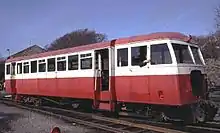 Railcar No. 19 & 20 in preservation on the IOMR. |
| No. 20 | 1951 | Great Northern Railway (Ireland) and Walker Brothers | Diesel | Sold to and preserved on the Isle Of Man Railway in 1961. |  |
See also
References
- ↑ Railway Year Book 1912 Railway Publishing Company
- ↑ The Industrial Archaeology of Northern Ireland. William Alan McCutcheon, Northern Ireland. Dept. of the Environment, Fairleigh Dickinson University Press, 1984
- ↑ Robert Robotham; et al. (1999). The Last Years of 'The Wee Donegal': The County Donegal Railways in Colour 1950–59. Colourpoint Books. ISBN 978-1898392422.
- ↑ Patterson, Edward M. (1962). The County Donegal Railways (1972 ed.). Pan Books. p. 58. ISBN 0-7153-4376-9.
- ↑ Britain Between the Wars: 1918–1940. Charles Loch Mowat, Taylor & Francis, 1968
- 1 2 Patterson, Edward M. (1962). The County Donegal Railways (1972 ed.). Great Britain: Pan Books. pp. 143–154, 206–209.
- ↑ https://www.irishstatutebook.ie/eli/1971/act/14/enacted/en/html Transport (Miscellaneous Provisions) Act, 1971
- ↑ "Fintown Railway – An Mhuc Dhubh". Archived from the original on 13 April 2009. Retrieved 21 April 2009.
- ↑ "Donegal Railway Heritage Centre". Archived from the original on 21 March 2011. Retrieved 11 May 2011.
- ↑ Archived 19 November 2007 at the Wayback Machine
- ↑ Crombleholme, Roger (2005). The County Donegal Railways Companion. England: Midland. pp. 15–26. ISBN 1-85780-205-5.
- ↑ Patterson, Edward M. (1962). The County Donegal Railways (1972 ed.). Pan Books. pp. 155–177, 210–211. ISBN 0-7153-4376-9.
Further reading
- Architectural Heritage of the Narrow Gauge Railways of County Donegal. County Donegal Railway Restoration Ltd. 2003.
- "North West of Ireland Railway Preservation Society". The Phoenix. County Donegal Railway Restoration Ltd. 1–23. 1992–2005.
- Begley, Joe (1995). The County Donegal Railway A Visitors Guide. ISBN 1-874518-04-1.
- Bell, Dave (2001). County Donegal Railway Restoration Society 10 years.
- Flanders, Steve (1996). The County Donegal Railway An Irish Railway Pictorial. ISBN 1-85780-054-0.
- Crombleholme, Roger (2005). The County Donegal Railways Companion. ISBN 1-85780-205-5.
- Patterson, Edward M. (1969). The County Donegal Railways. ISBN 0-7153-4376-9.
- Donegal's Railway Heritage. Vol. 1 (South Donegal). South Donegal Railway Restoration Society. 1994. ISBN 1-874518-01-7.

